Modern outdoor cooking gear can dramatically reduce your energy use while enhancing your camping experience. You'll find thermoelectric camping stoves that convert heat into electricity, storing power in built-in batteries for device charging. Solar cookers reach up to 180°C without any fuel, while portable power stations pair with solar panels for sustainable energy. Efficient accessories like double-walled cookers and thermal bags maximize heat retention, cutting fuel needs. Clean-burning wood stoves and rocket stove setups help minimize consumption, and innovative solutions like the PowerPot generate electricity while you cook. Discover how these smart technologies can transform your outdoor kitchen setup.
Thermoelectric Camping Stove Systems
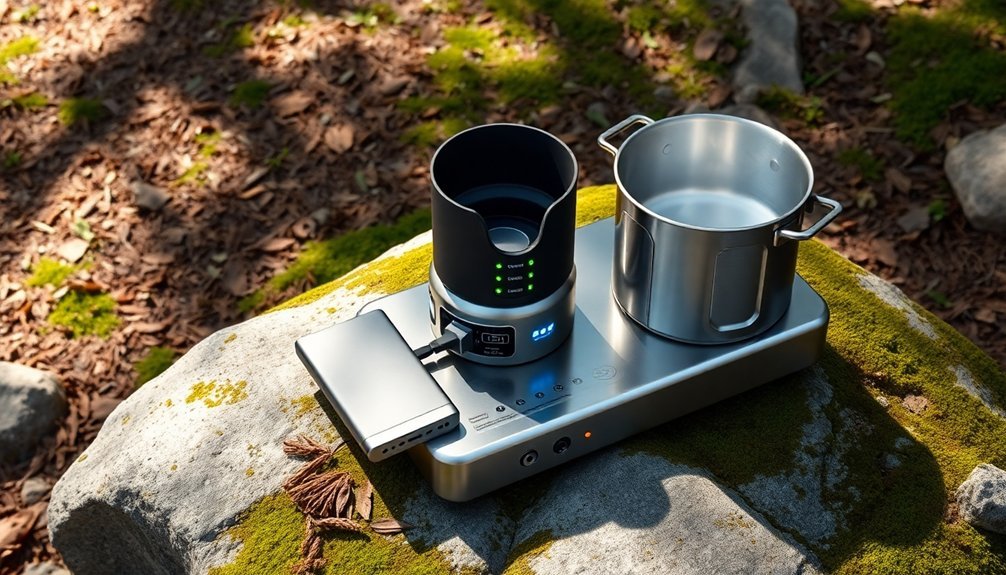
Thermoelectric camping stoves represent a revolutionary advancement in outdoor cooking technology, combining traditional fire-based heating with modern power generation capabilities.
You'll find these innovative systems use heat from your campfire to generate electricity through thermoelectric generators, similar to how solar panels harness sunlight.
You can power these stoves with wood pellets, stick wood, or charcoal briquets while the internal fans optimize combustion and reduce smoke output.
The system's built-in batteries store excess power, letting you charge phones, GPS watches, and other devices through USB and DC ports. The 6000mAh battery capacity provides significantly more charging power than many competing models.
You'll typically get 5-8 watts of power output, enough to keep essential electronics running during your outdoor adventures.
The stoves' durable construction features metal components and foldable legs, making them both robust and portable for your camping needs.
Solar Energy Cooking Innovations
Modern solar cooking equipment puts the power of the sun directly into your hands with portable units that can reach temperatures up to 180°C.
You'll find innovative designs ranging from compact box cookers to advanced parabolic systems, all offering zero-fuel cooking solutions for your outdoor adventures.
These solar units now come with enhanced power storage capabilities and multi-purpose features, letting you cook efficiently while camping, boating, or enjoying any off-grid activity. Leading models like the SunChef Pro provide large cooking capacity for groups of 10-50 people.
Portable Solar Cooking Units
Revolutionary portable solar cooking units harness the sun's energy to provide efficient, eco-friendly outdoor cooking solutions.
You'll find these lightweight devices are made with durable stainless steel and borosilicate glass, featuring advanced Suntube technology and adjustable reflectors to maximize solar heat capture.
These innovative cookers reach impressive temperatures of up to 600°F, letting you bake, boil, or fry food in just 10-20 minutes. The Pyrex cooking chamber can hold and efficiently cook up to 3 pounds of food at once.
They're incredibly versatile – perfect for hiking, camping, beach outings, or backyard cooking. At only 2 pounds, they're easy to transport and store.
You'll save money and help the environment since these units don't require fuel, gas, or electricity.
They're especially valuable in developing regions, where they help prevent deforestation while offering a sustainable cooking alternative.
Efficient Power Storage Systems
Building upon the convenience of portable solar cookers, efficient power storage systems now enable solar cooking even after sunset.
You'll find these innovative systems can store thermal energy during daylight hours, allowing you to prepare meals when sunshine isn't available.
The technology works by capturing and retaining solar heat through specialized absorber covers with enhanced optical properties.
These covers transmit visible light while blocking infrared radiation, maximizing energy storage efficiency. Similar to how heat exchanger pots improve fuel efficiency in traditional stove systems, these solar storage solutions optimize energy retention.
You can use this stored power to maintain cooking temperatures comparable to traditional fuel methods.
This advancement makes solar cooking more practical for your daily needs, as you're no longer limited to daytime use.
Whether you're camping or living off-grid, these storage systems guarantee you'll have reliable cooking power while reducing your carbon footprint and eliminating the need for conventional fuels.
Multi-Purpose Solar Equipment
Solar cooking equipment has evolved beyond simple box cookers into versatile multi-purpose systems that'll transform your outdoor cooking experience.
You'll find innovative designs like the GoSun Original Solar Kitchen and SolarTable 60 that combine cooking, cooling, and device-charging capabilities in one unit.
These modern systems let you cook for 4-6 people using the sun's energy during daylight hours, while offering electric backup for nighttime use. You can prepare various foods from burgers and steaks to pizzas and bread, similar to traditional grills.
The equipment typically features reflective surfaces and solar tracking systems to maximize sunlight concentration.
When you're looking to reduce your carbon footprint, these multi-functional units offer a practical solution that's especially valuable in areas with limited fuel access.
Natural Fuel Cooking Methods
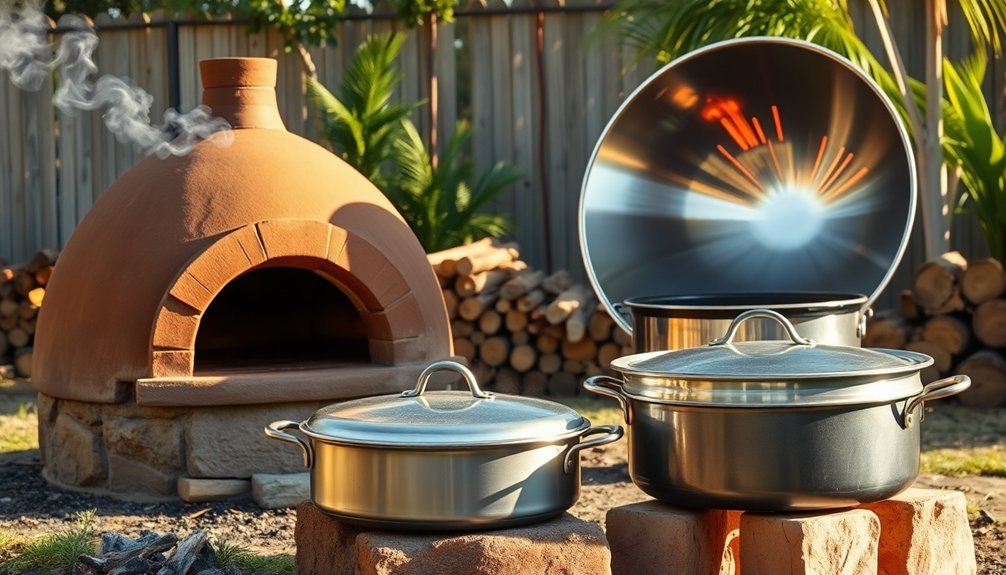
When selecting natural fuel for your outdoor cooking, clean-burning sticks and properly seasoned firewood can make a significant difference in both heat output and smoke control.
You'll find that smaller diameter sticks catch fire more quickly and produce less smoke than larger logs, making them ideal for starting your cooking fire.
Recent innovations in firewood management, including pre-cut sizing guides and moisture meters, help you maximize fuel efficiency while maintaining consistent cooking temperatures.
Sticks for Clean Burning
To achieve clean-burning fires for outdoor cooking, selecting the right sticks and wood pieces makes a significant difference. You'll want to gather small, dry sticks that break down into coals more quickly than large logs. This promotes complete combustion and reduces smoke output.
When you're collecting fuel, stick to dead and fallen materials to protect living trees. You can break these down manually or with an ax rather than using gas-powered tools that create emissions.
For the most efficient burn, arrange your sticks to allow proper airflow and consider using them in a rocket stove setup. These stoves maximize heat output while minimizing fuel consumption.
If you're looking for an alternative, wood pellets offer consistent heat and come from compressed sawdust, making them an eco-friendly choice for outdoor cooking.
Firewood Efficiency Innovations
Recent innovations in firewood cooking have revolutionized how outdoor enthusiasts can maximize fuel efficiency while minimizing environmental impact. Modern designs incorporate optimized combustion chambers and advanced insulation techniques that'll help you get more heat from less wood.
- You'll find secondary combustion chambers that burn remaining gases and particulates, cutting emissions while boosting efficiency.
- You'll benefit from well-insulated cooking surfaces that retain heat longer, reducing the amount of wood you need.
- You'll notice faster cooking times through rocket-stove principles that optimize oxygen flow and temperature control.
These innovations don't just save you money on fuel costs – they're also helping combat deforestation and reduce greenhouse gas emissions.
With precise temperature control and improved heat distribution, you'll achieve better cooking results while using considerably less firewood.
Heat Management Tools
Mastering outdoor cooking requires precise heat control, and the right tools make all the difference.
Ceramic and stone heat deflectors distribute heat evenly across your grill's surface, reducing gas consumption while preventing flare-ups. They're particularly effective in kettle and Kamado grills, covering up to 270 square inches of cooking area.
You'll want to invest in a digital Bluetooth thermometer like the ThermoPro TP20, which sends temperature updates directly to your smartphone, ensuring perfectly cooked dishes every time.
For safety, use heat-resistant gloves that protect against temperatures up to 932°F, paired with fire-retardant aprons for added protection.
Don't forget insulated cookware like cast iron skillets and non-stick grill mats. These accessories help maintain consistent temperatures while preventing delicate foods from falling through the grates.
Portable Power Storage Solutions
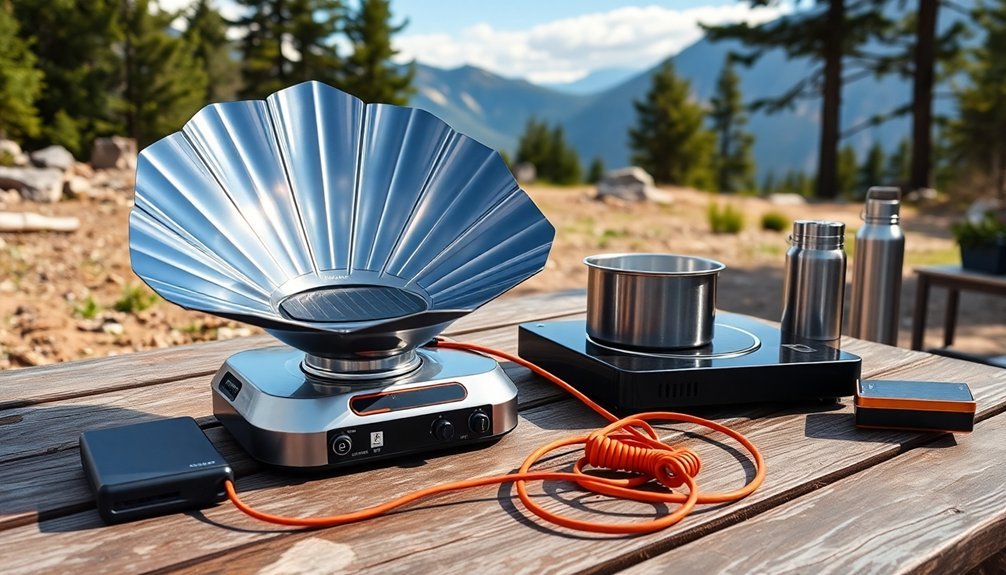
Modern outdoor cooking adventures demand reliable power sources, and portable power stations have revolutionized the way we energize our equipment. You'll find these efficient devices offer multiple power outputs while maintaining zero emissions, making them perfect for eco-conscious outdoor cooking.
- You can charge these stations through solar panels, eliminating the need for traditional fuel costs while providing sustainable power for your cooking appliances.
- They're weather-resistant and require minimal maintenance, letting you focus on cooking rather than managing fuel or cleaning up ash.
- You'll have peace of mind knowing your cooking won't be interrupted, as these stations provide consistent power regardless of conditions.
These lightweight, versatile units power everything from electric grills to blenders, ensuring you'll always have the right energy solution for your outdoor culinary needs.
Eco-Friendly Cooking Accessories
As outdoor enthusiasts embrace sustainable practices, eco-friendly cooking accessories have become essential gear for mindful adventurers. You'll find a range of sustainable options that reduce environmental impact while enhancing your cooking experience.
| Eco-Friendly Item | Key Benefit |
|---|---|
| Bamboo Utensils | Sustainable material, durable construction |
| Spoontulas | Multi-purpose design saves space |
| Stainless Steel Sets | Long-lasting, reduces waste |
| Biodegradable Plates | Eco-conscious disposal |
Your cooking kit can include reusable plates and utensils made from sustainable materials like bamboo or stainless steel, greatly reducing single-use waste. Consider investing in collapsible accessories that save space while maintaining functionality. Multi-purpose tools like spoontulas help minimize your gear while maximizing utility. When selecting cookware, look for durable materials that'll last for years of outdoor adventures.
Energy Generation While Cooking
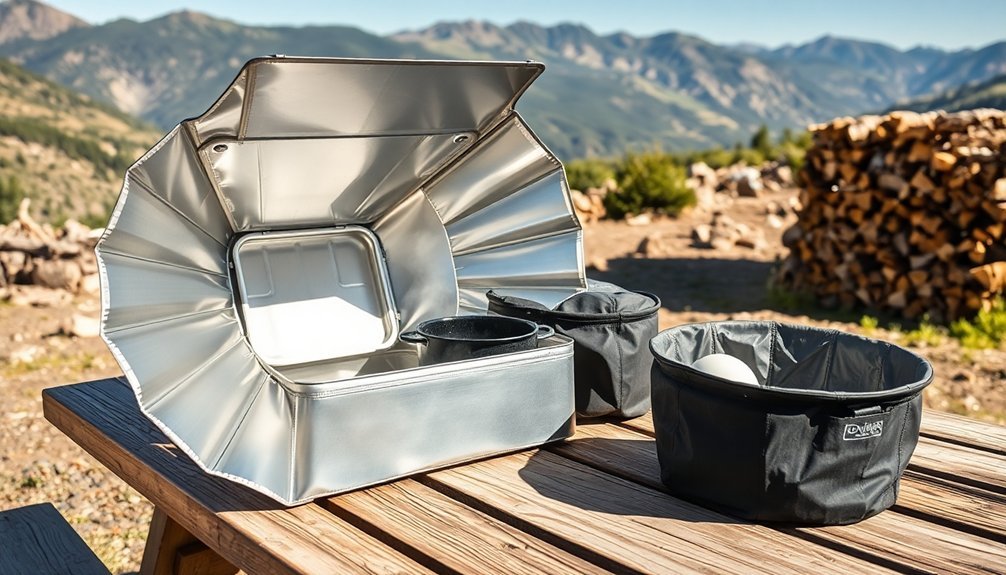
You'll find several innovative options to generate power while preparing your outdoor meals, from solar ovens with built-in USB ports to thermoelectric camp stoves that convert heat into electricity.
Modern heat-to-power systems can charge your devices using the excess thermal energy produced during cooking, making your outdoor kitchen setup more efficient.
Whether you're using a BioLite stove that powers its own fan or a PowerPot that generates electricity while boiling water, these dual-purpose cooking tools help you maximize your camping resources.
Heat-to-Power Cooking Systems
Recent advancements in outdoor cooking technology have introduced innovative heat-to-power systems that capture excess thermal energy from cooking processes to generate usable electricity. By using efficient fuel sources like propane or natural gas in combination with heat-capture technology, you'll maximize both cooking and power generation potential.
- When you're using an Alfresco Versa Power Burner at its full 65,000 BTU capacity, you can harness significant thermal energy while maintaining precise temperature control.
- You'll optimize energy capture by matching your pot size to the burner and using copper-bottomed cookware, which transfers heat more efficiently.
- If you combine these systems with solar technology during daylight hours, you'll create a hybrid cooking setup that maximizes power generation.
These systems work best when you integrate multiple energy-efficient cooking techniques into your outdoor kitchen setup.
Charging While Camp Cooking
Building on modern heat-capture technology, camp cooking now offers multiple ways to generate and store power while preparing meals outdoors.
You'll find portable power stations that provide reliable energy through multiple ports, making them perfect for indoor and outdoor use without the mess of traditional campfires.
Solar-powered charging systems let you harness renewable energy through waterproof panels, rapidly charging your power station while reducing your carbon footprint.
With efficient battery storage systems, you can track power output through LED dashboards and store excess energy for later use.
Integrated charging systems transform heat into electricity through thermoelectric generators, powering internal fans and USB devices.
These smart solutions seamlessly work with your cooking equipment, ensuring you've got consistent power while preparing your outdoor meals.
Sustainable Outdoor Kitchen Equipment
Creating a sustainable outdoor kitchen starts with selecting eco-conscious equipment that minimizes environmental impact while maximizing functionality.
You'll want to focus on energy-efficient appliances made from durable materials like 304 stainless steel, which can be recycled at the end of their lifecycle.
Set up your sustainable kitchen with these key elements:
- Electric grills instead of charcoal or propane options to reduce pollution
- LED or solar-powered lighting with motion sensors to minimize energy waste
- Reusable dinnerware made from sustainable materials like bamboo or bioplastics
Don't forget to establish a proper waste management system with dedicated recycling bins and a composting area.
You'll find that high-quality, sustainable equipment often comes with strong warranties, ensuring you won't need frequent replacements while supporting environmental conservation.
Alternative Energy Cooking Options
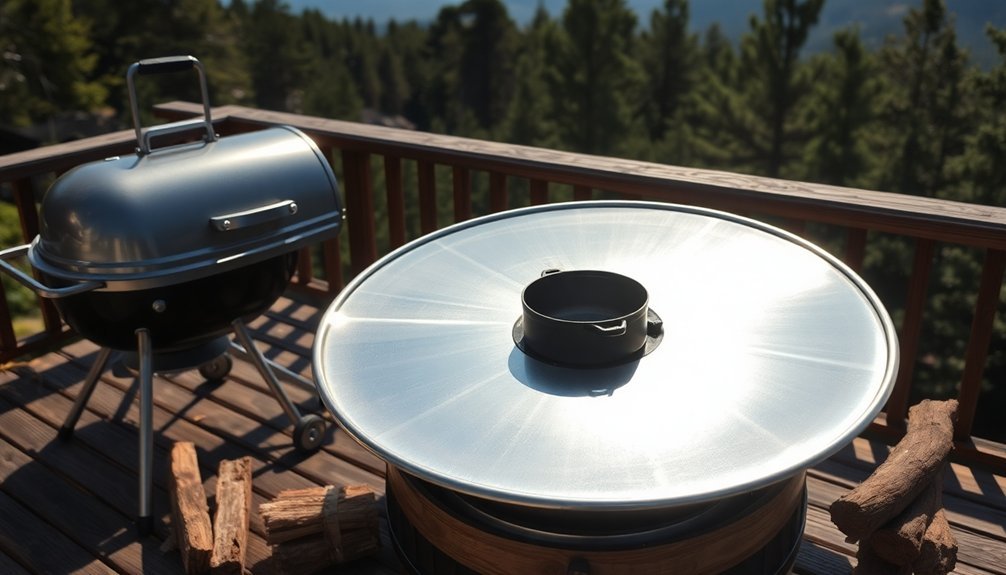
While sustainable outdoor kitchens form the foundation of eco-friendly cooking, exploring alternative energy options can take your outdoor culinary experience to the next level.
You'll find solar-powered cooking systems that harness free solar energy, though they work best in sunny conditions.
Biogas systems offer an innovative way to convert your organic waste into cooking fuel, providing several hours of cooking time from just a few kilograms of waste.
If you're looking for efficient biomass options, advanced stoves can reduce emissions by up to 95% while using less fuel than conventional methods.
For those with reliable power access, electric and induction stoves provide precise temperature control and clean cooking.
They're safer and more efficient, but you'll need to guarantee you have consistent electricity, preferably from renewable sources.
Green Cooking Technologies
Modern green cooking technologies have revolutionized outdoor meal preparation by combining efficiency with environmental responsibility.
You'll find that induction cooktops and pressure cookers considerably reduce cooking time while using less energy. Gasifier cookstoves efficiently convert solid fuel into gas, making them an excellent choice for eco-conscious outdoor enthusiasts.
When selecting green cooking technologies for your outdoor adventures, consider these innovative options:
- Retained heat cookers that keep food hot for 3-4 hours after initial cooking
- Integrated cooking systems that combine solar, retained heat, and improved cookstove methods
- Solar cookers that harness natural energy for cooking and water boiling
These technologies don't just save energy – they're designed to maximize heat retention and minimize fuel consumption, making your outdoor cooking experience both sustainable and efficient.
Frequently Asked Questions
How Long Does It Take to Charge Devices Using Camping Stove Power?
You'll need 4-6 hours to charge your phone fully using the CampStove 2. It'll charge faster if you're not cooking simultaneously, and you can get a 50% charge when the stove's battery is full.
Can These Eco-Friendly Cooking Systems Work Effectively in Extreme Weather Conditions?
Yes, you'll find eco-friendly cooking systems work well in extreme weather, especially liquid fuel and propane stoves. They're designed with windscreens, pressure regulators, and PerfectFlow technology to maintain steady heat in challenging conditions.
What's the Average Lifespan of Solar Panels Used in Outdoor Cooking Equipment?
You'll typically get 25-30 years from solar panels in cooking equipment, though they'll continue working beyond that with reduced efficiency. Proper maintenance and protection from extreme weather can help maximize their lifespan.
How Much Money Can You Save Annually by Switching to Sustainable Camping Gear?
You'll save around $200-400 annually by switching to sustainable camping gear through reduced fuel costs, longer-lasting equipment, and elimination of disposable batteries. Solar cooking and efficient stoves contribute most to these savings.
Are There Maintenance Requirements for Keeping Thermoelectric Generators Running Efficiently?
You'll need to inspect your thermoelectric generator annually, replace the orifice every 3 years, and change the battery every 5 years. Regular monitoring of temperature and voltage helps maintain peak efficiency.
In Summary
You've got multiple energy-efficient outdoor cooking options at your disposal. Whether you're using solar ovens, thermoelectric stoves, or natural fuel methods, these sustainable solutions help reduce your environmental impact while enjoying outdoor meals. By combining these with proper heat management tools and portable power storage, you'll maximize energy efficiency. Don't forget to explore emerging green technologies that'll make your outdoor cooking even more environmentally friendly.

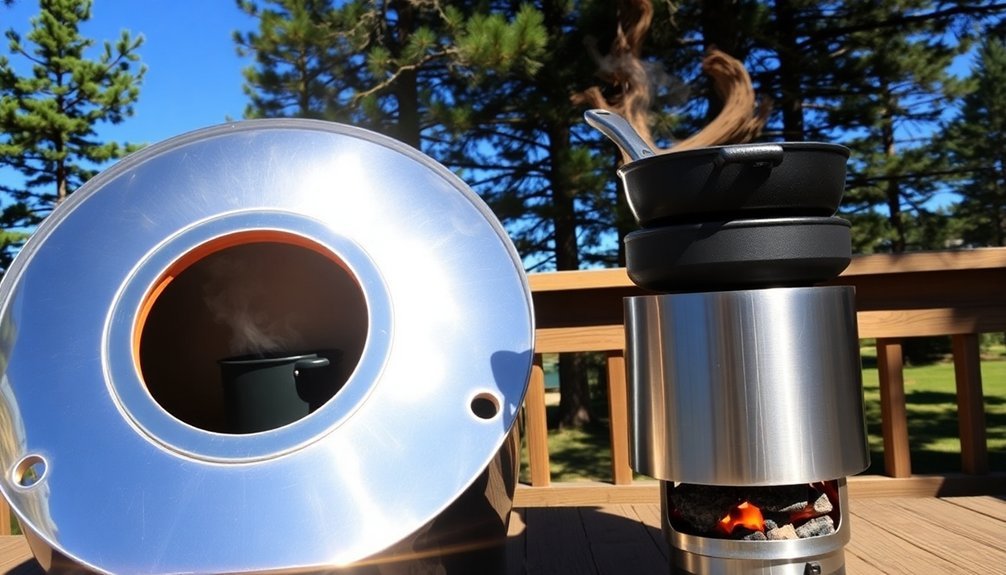



Leave a Reply